Travel: So much more fun than Zoom!
With the exception of flying, that is … Flying hasn’t been fun since about my eight hundred thousandth mile. But luckily, all my July and August travel has been by car to nearby states, or by foot out to the Ball Gardens here in West Chicago. Last time, I covered the Michigan Garden Plant Tour; this time, I’ll share one more bit from there, plus Ball Seed’s Customer Day (video attached!) and Plantpeddler Variety Day 2021 (which includes my portion of the “Titans of Horticulture Sound Off” presentation).
A quick apology
For forgetting to inform you that the Michigan Garden Plant Tour was coming up, so you could make plans to attend, a lapse for which I was taken to task by one of my faithful readers. Not that we didn’t write about it—it was in the June GrowerTalks and it’s always listed on the world-famous official horticulture industry calendar, www.hortcalendar.com—but I never mentioned it in Acres Online until I was covering it.
I’ll try to do better! And starting now: While the official dates of the 2022 MGPT haven’t been announced, it seems to me it’s always the last week of July and the first week of August, so I’ll go out on a limb and tell you to mark your calendar now for July 25 through August 5, 2022.
Now you can’t say I didn’t tell you.
Four Star’s expansion, automation
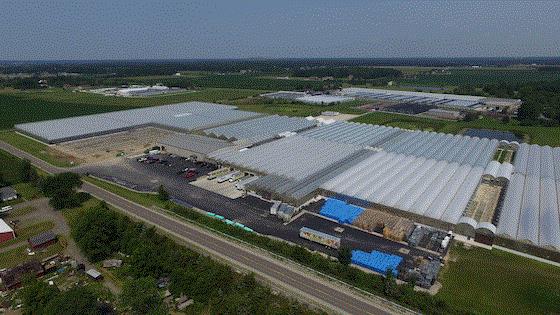
Our Michigan Garden Plant Trip two weeks ago was a bit of a three-day whirlwind, with little time to linger and tour the greenhouse facilities at which we stopped. But we reserved an extra hour at our last stop, Four Star Greenhouse, the Midwest home of Proven Winners, because we’d heard they were hard at work building some new greenhouses. Plus, they have North America's first “Flying Forks” internal transport system, which I’ve been dying to see in action.
The new greenhouse
What you’re seeing below is 70,000 sq. ft. of Westbrook Apex greenhouse that will be used for propagation and, afterwards, finished plants. This will add almost 2 acres to Four Star’s current 27 acres of greenhouse production space.
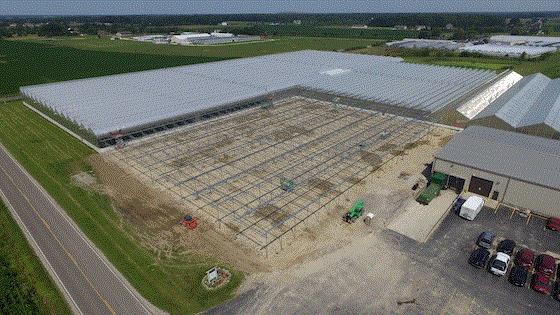
Dimensions are 321 ft. x 300 ft. (five 42-ft. bays and one 21-ft. bay). Gutter height is 16 1/2 ft. Ten thousand square feet will be reserved for storage. The greenhouse will be fan vented (no pads), with fans on the east and a single roof vent on the far west end (in the 21-ft. bay). MicroCool foggers will help with cooling. Glazing will be double poly.
Why no open roofs? Loss of light from the extra structure they require, says my good friend Jeff Back, Director of Greenhouse Operations and our tour guide.
“The open roof houses that we have now, we have a hard time propagating in them because they’re so dark.” Jeff says they’ll most likely add LED lighting.
Another problem with open roofs is Japanese beetles. They have to screen everything for them during the summer and open-roof houses require an entire curtain system.
Equipment wise, Four Star will install the usual high-tech stuff: high-speed doors, concrete flood floors, in-floor and forced air heat, irrigation booms (by GTI), and a Boomerang hanging basket system (also by GTI), which will be equipped with the Oasis water-by-weight system by ControlDekk of Jenison, Michigan.
You need soil-mixing capacity to support new space, and Four Star’s current 30-yd.-capacity line no longer cuts it, so they’ll be tripling their mixing capacity with a new 100-yd. soil-blending line by Pack Manufacturing. It will include the ability to incorporate HydraFiber wood fiber into their mix.
Jeff says they expect to move in by mid to late December.

Flying Fork—The first in North America
In a greenhouse dedicated to growing and finishing ColorChoice shrubs, Four Star has installed the first AgriNomix “Flying Forks” internal transport system in North America (admittedly, Four Star’s was installed in 2017 and I saw the Fork at Cultivate, but this was the first time I’d seen it in action, and I figure if it’s new to me, it might be new to you, too). Since then, AgriNomix has installed another system at The Plant Company in Virginia.
This is a hybrid manual/mechanical system that allows one worker to pick up, move and set down many pots at one time—the capacity depends on the pot size. In the picture below, Jeff is moving 91 1-gal. pots. Shrubs need several trimmings or shapings during production, and the forks let workers move plants to and from the production area where this process is automated.

Only rotation of the fork is done manually; the rest of it is controlled much like a powered pallet jack (the control handle may have come from one). There are three forks, each with its own gantry, serving five greenhouse bays via rails along each bay. There’s an additional fork in the production area. The only downside to the system? The risk of irrigation booms crashing into unattended forks.
Why Flying Forks instead of a dedicated forklift or other proven method? Because they’re growing on “Erfgoed” flood floors, which, being made of gravel, can’t accommodate wheeled transport systems—even carts need to be run on metal tracks (which you can see in the image).
Now, if AgriNomix could just come up with a “Flying Knife,” Four Star could trim plants right in the greenhouse …

Ball Seed Customer Day
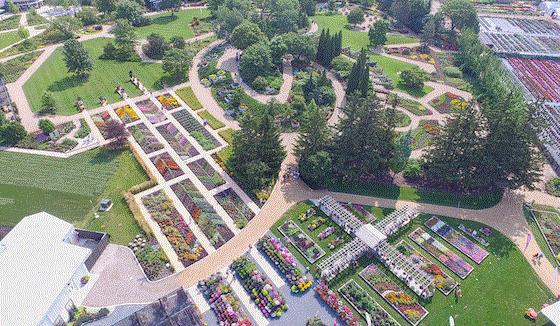
Just minutes, seemingly, after returning from Michigan, Jen Zurko and I hiked the grueling 100 yards from our offices down into the Gardens at Ball to cover the annual Ball Seed Customer Day, this year held over not just one, but three days, July 28, 29 and 30. According to Ball’s Anne Dieter, more than 1,000 visitors representing some 400 companies from 17 states attended one of the three days.
The gardens this summer are extra-resplendent with annual, perennial and woody ornamental color. I don’t know if it was a good growing year or the gardeners were feeling inspired, but the place looks fantastic, so if you didn’t make it by for one of the three open days, you can still pop by for a look if you are in town (622 Town Road, West Chicago, Illinois).
What were the highlights? According to our tour guides, they were Wave E3 Petunias from PanAmerican Seed; Bee’s Knees Petunia from Ball FloraPlant (introduced last year during COVID, so still “new,”), Chrysalis Buddleia from Darwin Perennials; Mexican Sour Gherkin from Burpee; and the four sizes of Jurassic Rex Begonias from Ball Ingenuity.
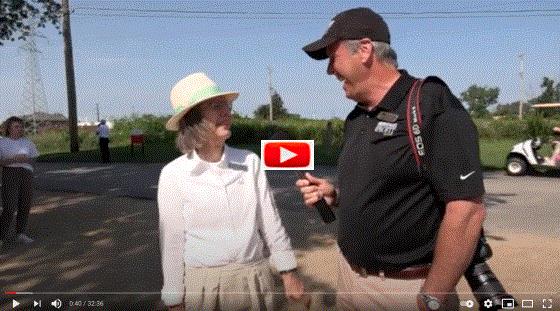
Check those out, and find out what Anna Ball her own self enjoyed most about Customer Day, HERE!

Happy 41 to Plantpeddler!
That’s a weird, non-round anniversary to celebrate, but COVID has resulted to weirdness on many levels, and when your 40th falls during a pandemic, you may not get as many visitors (although in 2020, Mike reported attracting 300 “well-distanced” attendees). I was not one of them, which is why I, along with Jen Zurko and Publisher Paul Black made the extra effort to attend Plantpeddler’s Variety Day ’21 to help Mike and Rachel Gooder and their family celebrate 41 years of ownership.
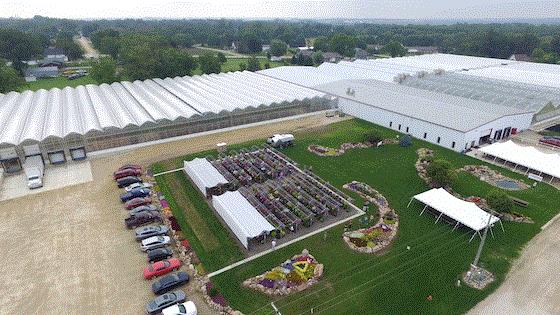
What was once a small retail grower operation is now a major rooting station (but still a retail grower), serving the entire country with liners and the upper Midwest with finished plants, and their reach is evidenced by the nearly 400 people from 17 states who made the drive to Cresco, Iowa, and its two traffic lights.
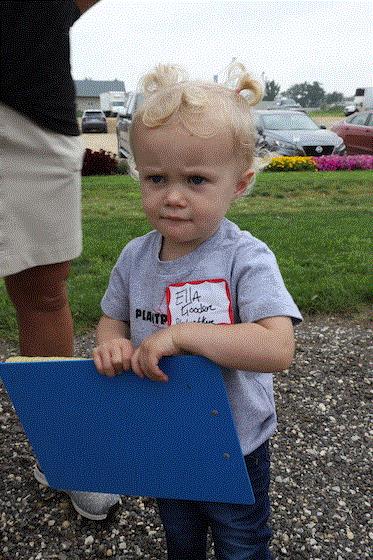
Third-generation trial manager Ella Gooder.
The Variety Day featured several presentations, plus a chance to tour Plantpeddler’s sophisticated greenhouses and production area, see their three ISO cutting sticking robots in action, and, of course, view the trials themselves, which included almost 1,500 varieties from 18 breeders in almost 900 pots and hanging baskets, plus various decorative beds.

The three favorites have a lot in common
Plantpeddler uses the tried-and-true “stick-a-flag-in-your-favorite” visitor voting system, and that resulted in these three taking the win, place and show titles: 1) Petchoa SuperCal Premium from Sakata; 2) Begonia Vermillion Red from Beekenkamp; and 3) Begonia I’Conia Del Sol from Dümmen Orange.
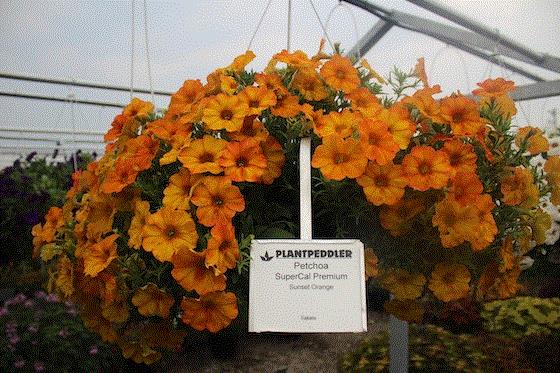 Petchoa SuperCal Premium
Petchoa SuperCal Premium
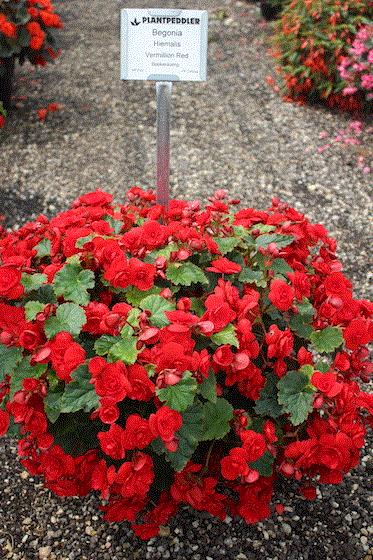 Begonia Vermillion Red
Begonia Vermillion Red
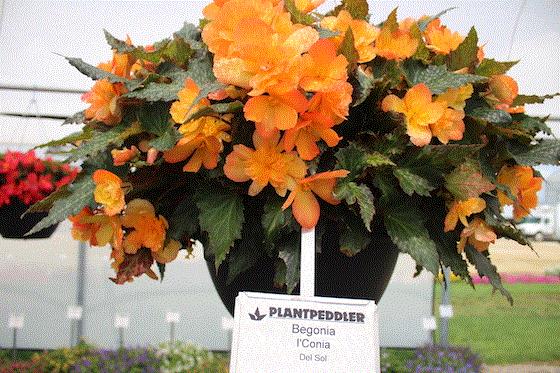 Begonia I’Conia Del Sol
Begonia I’Conia Del Sol
Note that two of the three share vivid orange coloration, and two of the three are begonias. That latter fact isn’t surprising, as Plantpeddler has long specialized in begonia liners and finished, and these simply looked great, as did the rest of the varieties in their large begonia display—which was the largest of any we’ve seen this summer.
ISOs in action
I’m not sure if our Amish colleagues who were in attendance would spring for one of these expensive labor-saving tools (an Amish lad I once met at the Ohio show would insist that when it comes to sticking cuttings, “That’s what children are for!”). But the rest of the audience watched in fascination as three ISO 2500 Cutting Planters each put a single variety into one of three lobes in Plantpeddler’s cloverleaf trays.
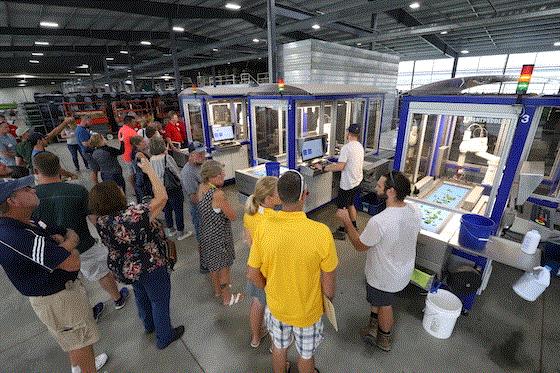
The technology will pay for itself in multiple ways, says Mike, including uniformity of the finished liners, which, because of robotic repeatability, are virtually identical and pretty much perfect when it comes to cutting spacing and depth.
Titans talk
This was funny: For 90 minutes, I was considered a “titan” of horticulture and sat alongside three true titans—(from left to right) Dave Daley, CEO and President of BFG Supply; Keith Cable, President of Dümmen Orange North America; and Mark Schermer, Global Head of Syngenta Flowers.
Whew! Some company, eh? Normally I ask the questions, not answer them, but somehow I held my own with these smart and worldly guys as emcee Mike Gooder and the audience fired questions at us.
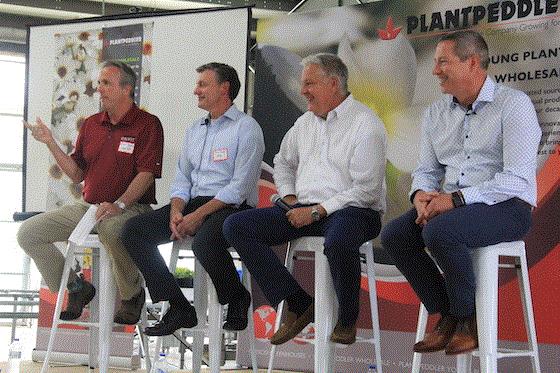 How can you tell the real titans? They wear dark slacks to a trial, not khakis.
How can you tell the real titans? They wear dark slacks to a trial, not khakis.
I don’t want to put the other guys’ answers here because I might mess them up (it’s hard to take notes while on stage). Suffice it to say that they're experts in supply chain management and logistics, and they all agree it’s still going to be a while before the supply chain get back to normal. Plants are easier to ramp up than plastics. And some things, like some prices, may not come back down. Certainly, labor is only going up.

As for my answers …
… I kept it practical, and hopefully, memorable. Here are some examples:
On raising prices: “Do not make the mistake of setting your prices based on your competition. You don’t have a clue what his production costs are. Price based on how much you need to make to cover all your costs and have some profit at the end of the year. If you think your customers will balk, well, first, if nobody is complaining about your prices, then they’re too low. And second, make sure your quality and service are so good, they won’t mind paying your price.”
On finding employees: “We have to catch them when they’re young. Not in high school, but grade school or earlier. Give away plants to kids, to their schools. Give them tours. Let them try a few hours of 'work.' To a 6- or 8-year-old, potting plants isn't work it's an adventure. You might just plant a seed that turns into a career.” (Then Mike Gooder admitted that everything we saw was the end result of a milk carton full of marigolds he grew for Mother’s Day back in kindergarten.)

My answers (continued)
On coping with shortages: I told the audience, “If Plantpeddler called you and said ‘I’m sorry, but we can’t get you those begonias you ordered,’ you’d ask to speak to Mike and you’d say, ‘Mike, buddy, remember how I drove all that way to come to your open house and supported you and Rachel and son John. Come on, old friend, I really need those begonias!’ And Mike would find them for you. Wouldn’t you, Mike?” I asked, turning the attention on him. He smiled and agreed he’d try. “It’s all about relationships,” I said. “Those with strong relationships with vendors, customers and even competitors fared better in the pandemic than the lone wolves.”
On the industry 10 years from now: “I can’t tell you what it will look like—nobody knows what will have changed. But I can tell you what will NOT change: Customers will still want information. They’ll still want inspiration. And quality—quality products and quality services—will still be in short supply and an untapped niche.”
Finally …
You know I’m always looking for good horticultural video storytellers. I’ve just found a new one—a fellow named Siloe Oliveira. His YouTube channel is called Suburban Homestead. Siloe is originally from Brazil, but now lives and gardens in suburban Baltimore. As you can tell from the word “homestead,” food and self-sufficiency is his thing, and he says he's striving to be “less dependent upon industrial agribusiness.”
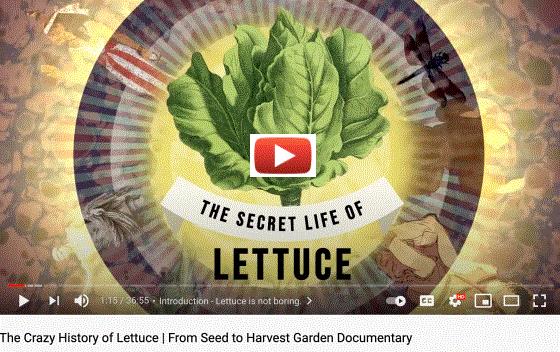
Now, while I might argue with his characterization of the important agricultural technologies that are feeding the world, I do NOT argue with his filmmaking skills—he’s an artist and illustrator, and those skills are evident in his videos.
Check out his YouTube page HERE. He’s done some amazing long documentaries, such as “The Crazy History of Lettuce” and “Cucumbers Made a Man Rich, After Bankrupting Him.” But there are plenty of short films on basil, tomatoes, carrots, building garden beds …
If you’re a vegetable gardener, you’ll enjoy Siloe’s work. And if you’re looking for new ways to tell stories about your business, you might steal some ideas from him.

See you next time!

Chris Beytes
Editor
GrowerTalks and Green Profit
This e-mail received by 25,158 loyal readers!
Thanks to my loyal sponsors, who help me reach the 25,158 readers of Acres Online in 66 countries. Want to be one of them (a sponsor, that is)? Give Paul Black a shout and he'll hook you up.